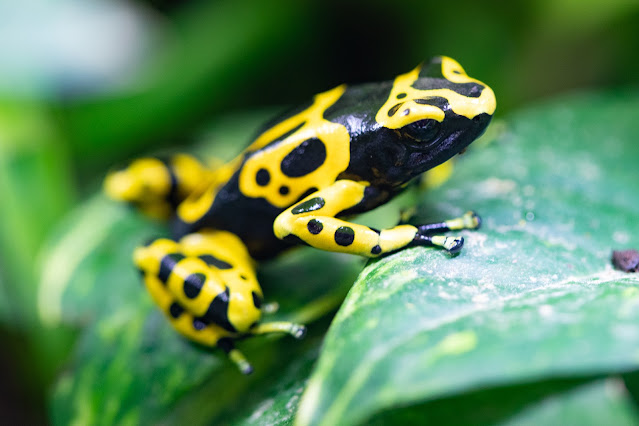Posted by Elizabeth Bacher, Communications
If you’ve been inside the Tropical Rain Forest building, you may have seen the colorful poison dart frogs there. If you haven’t visited in a while, now may be the perfect time for a reintroduction to these incredible amphibians.
 |
| Yellow-banded poison dart frog. Photo: Jeremy Dwyer-Lindgren/Woodland Park Zoo |
The poison dart frog is the common name for dozens of frog species which are native to the warm and wet environments of Central and South America’s tropical rain forests. They are so named because some Indigenous Amazon peoples historically used the toxic skin secretions from a few select species to poison the tips of their blow darts and arrows for hunting.
 |
| Green and black poison dart frog. Photo: Jeremy Dwyer-Lindgren/Woodland Park Zoo |
Like most amphibians, these frogs begin life as tiny, aquatic, gill-breathing tadpoles. They go through a metamorphosis as they grow, becoming terrestrial, lung-breathing adults that live amongst the trees, plants and leaf litter of the humid rain forest.
 |
| The poison dart frogs begin life as aquatic, gill-breathing tadpoles. Photo: Jeremy Dwyer-Lindgren/Woodland Park Zoo |
Some poison dart frogs have brightly colored bodies—yellows, oranges, reds, greens and blues—that serve as a visual warning to predators, signaling that they are toxic and to stay away. Scientists believe that the toxins, which they secrete through their skin, come in part from their diet of specific kinds of ants, termites and other bugs. While some of the most colorful species of poison dart frogs living in the wild are highly toxic, others including some that are more muted in color, are less so and some are not toxic at all.
 |
| Yellow-banded poison dart frog. Photo: Jeremy Dwyer-Lindgren/Woodland Park Zoo |
There are two species of poison dart frogs living in separate habitats in our Tropical Rain Forest building—the yellow-banded poison dart frog and the green and black poison dart frog. The green and black poison dart frog is native to Central America and the northern part of South America and grows to about 2 – 2.5 centimeters (about an inch) long when fully grown.
The yellow-banded poison dart frog has a home range in the northern part of South America—specifically in Venezuela, Brazil, Columbia and Guyana. They’re only slightly bigger than the green and black ones, reaching between 3 – 4 centimeters in length. That's about the height of a postage stamp!
 |
| Green and black poison dart frog. Photo: Dennis Dow/Woodland Park Zoo |
The toxicity levels of poison dart frogs that live in human care can be different compared to their wild counterparts. The reason is related to their diet—those in our care feed on bugs that have a different organic makeup than those that are available to be eaten by their South American relatives. In the case of our frog friends in the Tropical Rain Forest building, they thrive on a steady diet of locally raised fruit flies and small crickets. YUM!
 |
| Neither of them is expected to turn into a prince.😉 Photo: Jeremy Dwyer-Lindgren/Woodland Park Zoo |
: Many species of dart frogs are threatened or endangered due to habitat loss and climate change which affects the health of their rain forest ecosystems. You can be part of the solution. Every time you visit the dart frogs at Woodland Park Zoo, a portion of your ticket or membership fee helps us support organizations that are part of our
Wildlife Survival Program, including the Amphibian Ark. Healthy populations of amphibians are vital indicators of safe and healthy environments—so by focusing on the global survival of amphibians, the Amphibian Ark is also looking out for the health and well-being of other wildlife and people!
 |
| Forests are for ALL of us! Photo: Jeremy Dwyer-Lindgren/Woodland Park Zoo |
Learn more about why we need healthy forests—all kinds of forests—as the best solution to fight climate change. It’s all part of our
Forests for All Initiative—a movement to protect, restore, and sustain forests around the world for wildlife and people. We hope you'll join us!








Comments
Post a Comment